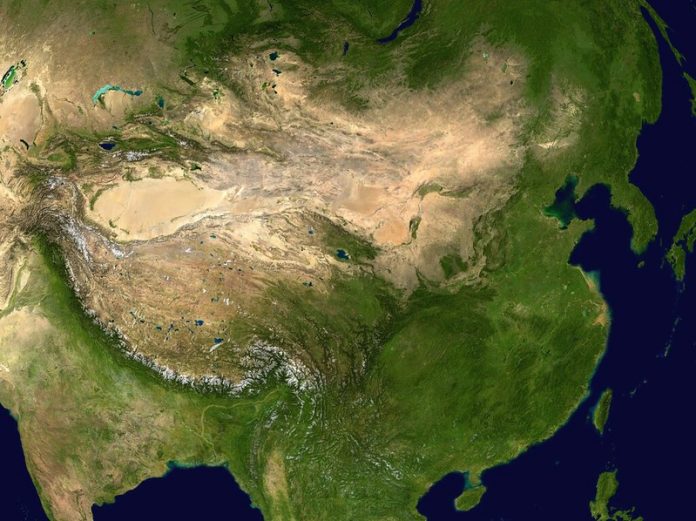The city of Yulin, in the Shaanxi province of China has abruptly halted all solar development this year, including under-construction projects with around a gigawatt of generation capacity.
The revelation was made by China-based German solar analyst the Asia Europe Clean Energy (Solar) Advisory (AECEA) in an update on the Chinese market released today.
Grid capacity and land constraints are thought to be behind the decision to reverse plans for an estimated 5 GW of new solar capacity in Yulin this year. The cumulative 4 GW of solar which had been installed in Yulin by the end of the year accounted for around 45% of the province’s 9.39 GW, according to the AECEA.
The consultancy also said solar export figures available for the first two months of the year indicated likely further consolidation of the PV manufacturing market. Although the biggest eight manufacturers – Chinese giants JinkoSolar, Canadian Solar, Risen, Trina Solar, JA Solar, Longi Solar and Chint, plus Korean outfit Hanwha – surrendered 2% of their combined market share of cell and module exports in January, year-on-year, they saw their slice of the cake leap 7.7% in February, according to the AECEA.
Exports
Export figures also showed the changing structure of the global industry with module shipments of 5,486 MW up 3% year-on-year in January, and down half a percent in February, to 3,879 MW. By contrast, cell shipments of 1,078 MW in January and 805 MW in February were up 133% and 115%, respectively.
The consultancy highlighted a consultation paper recently released by the National Development and Reform Commission which raised the suggested payments for feed-in tariff (FIT) backed solar projects by RMB0.02/kWh ($0.0028) to RMB0.35 in northern China and Inner Mongolia’s zone 1, to RMB0.40 for the zone 2 which encompasses the west and center of the nation, and to RMB0.49 in zone 3, which comprises the rest of the territory.
The National Energy Administration (NEA) has budgeted RMB1 billion ($141 million) for FIT-supported projects in what the AECEA predicts will be the last year of subsidy support ahead of the onset of the 14th five-year-plan next year. The consultancy said RMB500 million had been set aside for residential PV systems, which qualify for a fixed RMB0.08/kWh. Under the NEA auction scheme for determining FIT payments, provinces are required to submit details of unsubsidized and FIT-backed projects, along with the power price tariffs offered by developers for the latter, with the central body due to confirm which projects will secure backing in June.
New solar
The AECEA said the next five-year plan is likely to see solar lumped into the same strategic policy basket as hydro, wind, biomass and geothermal facilities despite the different technologies being afforded their own strategies during the current plan. The consultancy also noted a stated intent by the authorities to focus on higher efficiency and project quality in future, rather than sheer volume of generation capacity.
China added 30.11 GW of new solar capacity last year, according to the AECEA, a fall of 32% on the 2018 figure, with 12.2 GW of small scale projects – including 5.3 GW of residential rooftops – representing a 41% fall, year on year, and 17.91 GW of utility scale facilities an annual retreat of 23%.
The nation reportedly reached 204.3 GW of solar capacity by the end of December, for year-on-year growth of 17% and including 141.67 GW of utility scale projects. Shandong, which added 16.19 GW of solar in 2019, according to the AECEA, led the pack as one of ten regions which each had more than 10 GW of solar at that point and which accounted for 61% of Chinese solar capacity between them. Beijing, by contrast, had just 510 MW of solar at the end of the year, according to the consultancy. The more deprived province of Guizhoureportedly added the most new PV capacity last year, with 3.4 GW, ahead of Shandong, with 2.6 GW.
Contribution
The new additions lifted solar to “almost 10%” of China’s total power generation capacity although the volume of solar electricity generated – 224 TWh – added up to just 3.1% of Chinese generation last year. The country still faces hefty curtailment problems in some regions, with the AECEA stating Tibet saw 24.1% of the electricity it generated wasted last year.
Although Beijing is trying to drive the nation into a renewables-subsidy-free future, the AECEA reported only 2 GW of the 14.78 GW of grid-parity solar allocated last year was actually built. Less than 10 GW of the 22.8 GW of FIT-backed capacity approved came to fruition, according to the consultant, with administrative, managerial, technical and financial hurdles cited as the chief cause of those disappointing outcomes. Hebei province, in particular, reportedly only commissioned 7% of the solar projects allocated last year.
China reportedly connected around 4 GW of new solar in the first two months of this year although the AECEA stated around 1 GW of that was complete and awaiting a grid connection in December.
The consultancy predicted Covid-19 would delay project completions by up to six months and accordingly revised down its expectation for this year from the previous 34.5-37.5 GW to 23-31 GW. The analyst added, however, “Facing an unprecedented global crisis, currently in full swing, no end in sight yet, this present forecast is bound to be adjusted again in due course.”






